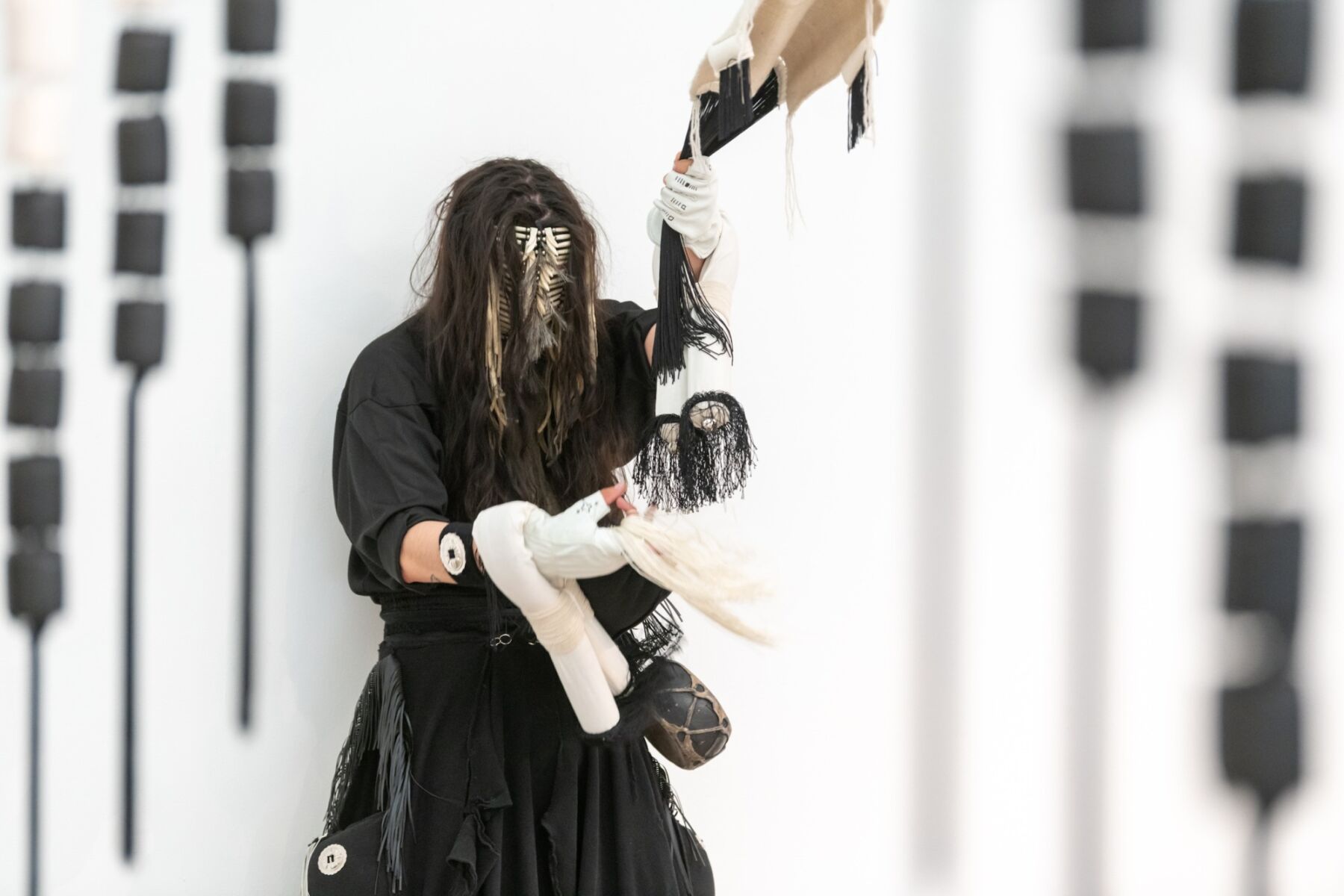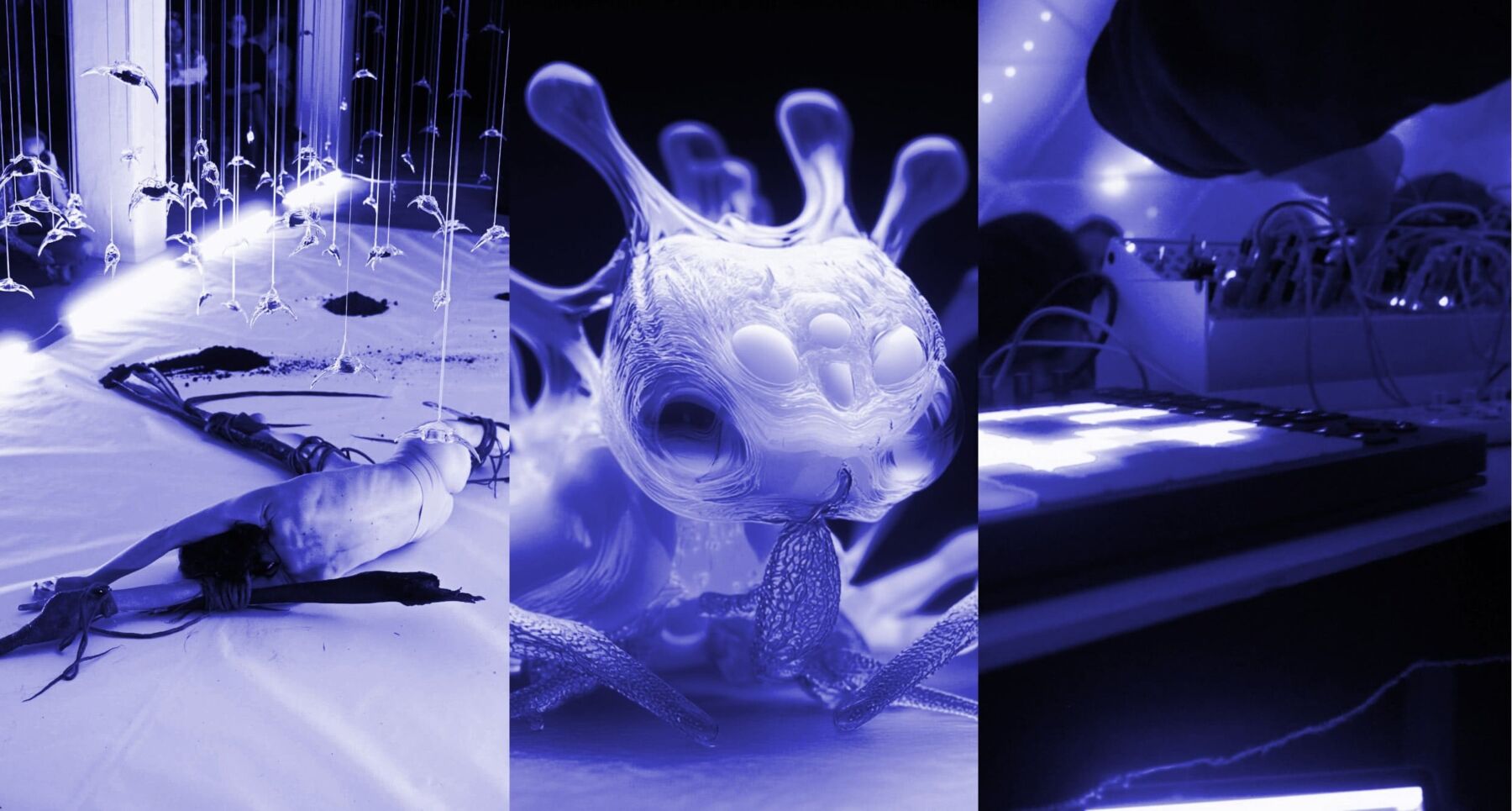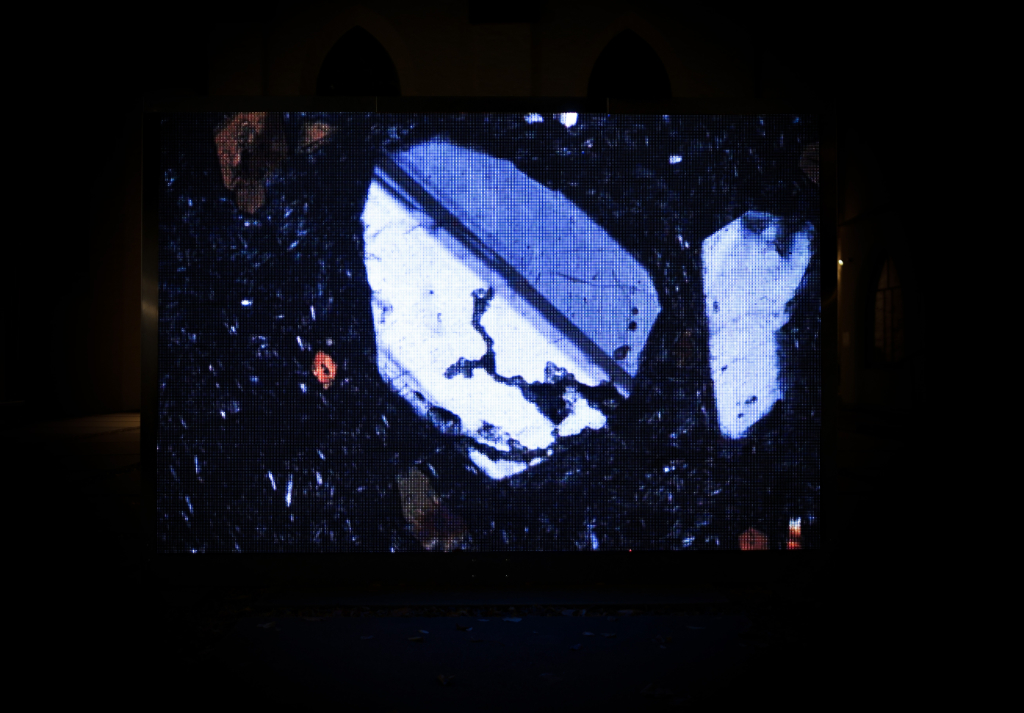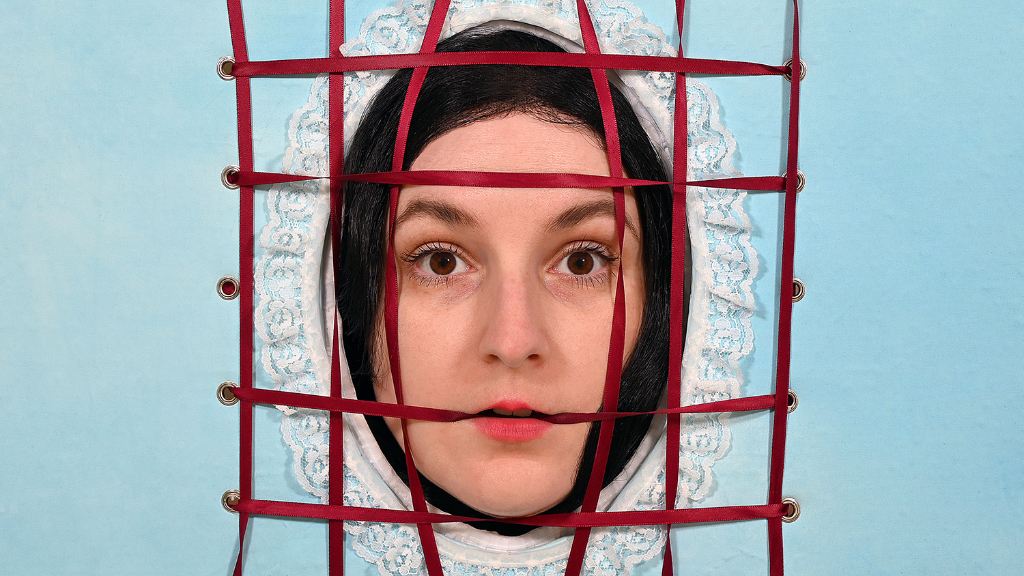Words by Meritxell Rosell

Reflections into the materiality of life, the core of existence itself, has been the creative motor of Oron Catts (along with his partner and main collaborator, Ionat Zurr). The artist, curator and visiting professor at the Royal College of Art (London) has been exploring the ethics and the mutating perception towards new technologies in the life sciences. His work in bioart (or biomedia) has always been at the forefront of the most cutting-edge artistic expressions reinterpreting scientific processes, working with tissue engineering and regenerative biology technologies in non-utilitarian contexts.
In 1996, Oron and Ionat began to work with biological materials as part of the Tissue Culture and Art Project (TC&A). A few years later, they founded SymbioticA, alongside Professor Miranda Grounds (one of the first scientists to open their laboratories to artists) and Professor Stuart Bunt. SymbioticA is a pioneering art research laboratory in the University of Western Australia’s School of Anatomy and Human Biology. This creative lab has been a research hub for many artists exploring boundaries between art and biology.
Tissue Culture and Art Project (TC&A) is well known for their artistic signature feature, the ”semi-living” entities/sculptures created using tissue and stem cell technologies. Works like the famous Semi-Living Worry Dolls, the first tissue-engineered sculptures to be presented alive in a gallery context. A post-contemporary version of the Guatemalan worry dolls, where to whisper all our biotechnological concerns away.
In Pig Wings, pig bone tissue was grown in the shape of wings, emulating the wings of a pterosaur, a bat, and an (imaginary) angel. Victimless leather: A prototype of a stitch-less jacket growth in a Technoscientific ‘body’ is one of his most famous pieces; a miniature leader jacket made of immortalized human and mouse cell lines that was presented at MoMA in the world-acclaimed 2008 exhibition Design and the Elastic Mind.
In these works, which can be presented as wet or dry sculptures, stem cells or cell lines from different species are seeded and expanded onto three-dimensional scaffolds. The sculptures have to be maintained in a cell culture incubator (usually at 37% and 5% of CO2) in sterile conditions and have to be “killed” (disposed of) when the exhibitions are over, usually involving a ritualistic performance in which the audience is engaged with too.
Remember all that fuss in 2013 about the laboratory hamburger? TC&A did it 10 years earlier. For Disembodied cuisine, they grew a semi-living steak out of frog cells. At the end of the exhibition (at L’art Biotech in Nantes), a French chef cooked some of the steaks, which were then served to volunteers from the audience as a sort of nouvelle cuisine-style diner.
Cell culture nowadays is one of the major tools used in life sciences. It provides consistent and reproducible model systems to study the pathophysiology of cells. It is also used in large-scale production of vaccines and drug screening. In a similar way, stem cells and tissue engineering have also become pivotal instruments for the most challenging regenerative medicine research. Oron Catts’ work delves deep into taking all these concepts outside the lab, not for banalization but for confronting and re-evaluating – in the flesh (never more appropriate) – what life is and our conduct towards other life forms.
In times when daring artists can fill in patents to produce leather goodies out of skin stem cells of deceased world-famous designers, we are eager to know what new speculative futures Oron Catts and the SymbioticA artists and researchers can find beyond.
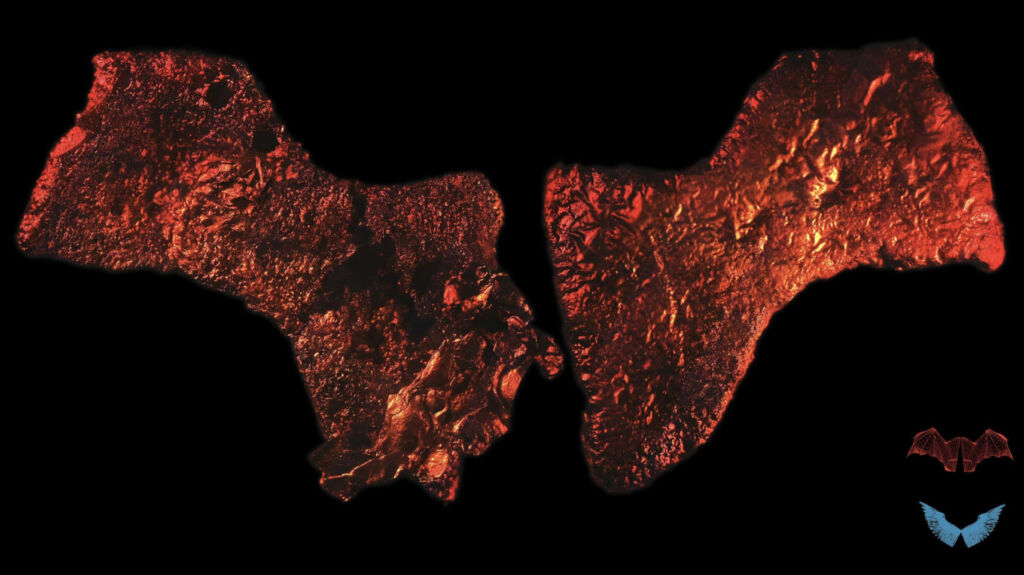
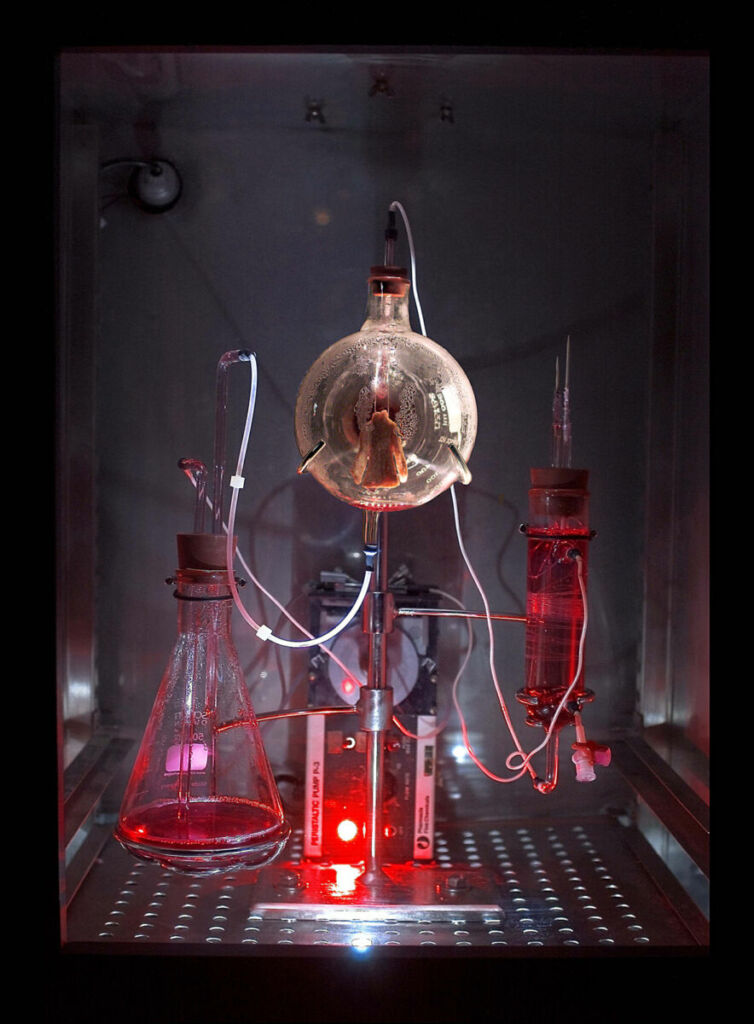
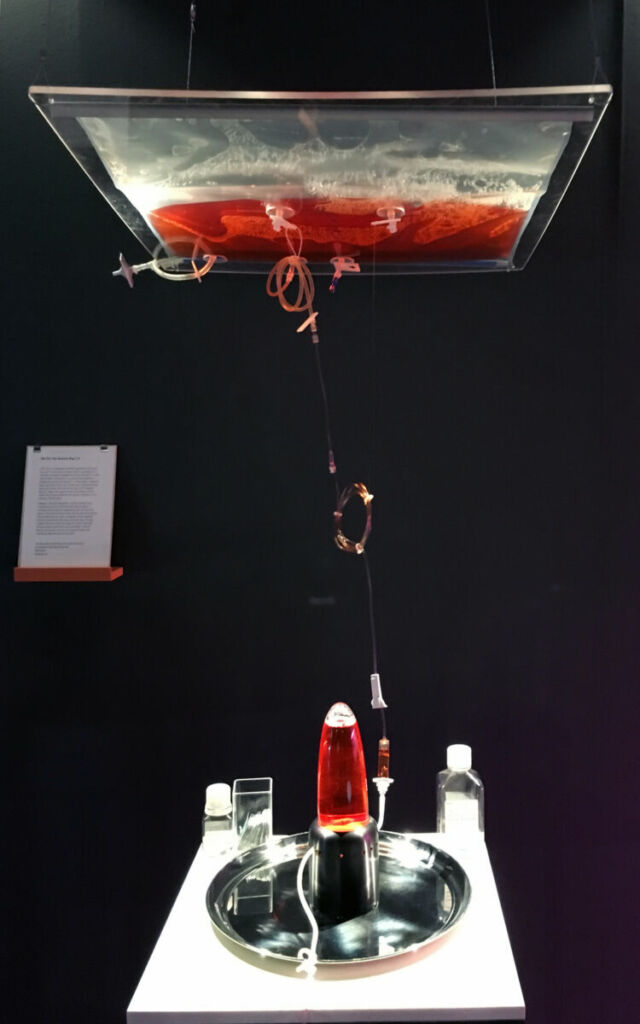
Both artworks by The Tissue Culture & Art (Oron Catts & Ionat Zurr).
As a visual artist, researcher and curator, your work is at the intersection of art and science. Could you tell us a little bit about the intellectual process that overaches your work?
The reason why I don’t talk about what I do in Art & Science is that I run a research centre in a science department, so I no longer need to resort to this rhetoric. Artists often use ‘Art & Science’ because they want a way into the science world. SymbioticA is a really special place because it’s a research centre integrated into a science faculty.
I am head of the research centre within this science faculty. Still, we do artistic research about our shifting relations to the concept of life, so it’s really important for me to distinguish what we do from the sciences. Personally, I must admit that my interest was never science for science’s sake; it was life.
I was interested in what was happening to life and how our relationship to life is shifting and changing, and it so happens that the most radical places where the idea of life is going through transformations are happening within the science and engineering world. That’s why as an artist, I found myself there.
I think the problem with a lot of the rhetoric around ‘Art & Science’ is that it puts art and science within confined hierarchal positions. Either you hear people talk about science-inspired art, or you talk about art as a way of explaining and illustrating the sciences. That’s not really the interesting bit; the interesting bit is how the scientific and engineering mindsets are incompatible with our cultural understandings of life. As an artist, I am interested in those points of tension.
Is art helping to understand scientific issues, or is it challenging what society understands about them?
I see myself as a critical artist, I’m not anti-science in any way or form, but I’m critical of the situation and the mindset that drives much of what is happening in science. Interestingly, biology is mostly not a science anymore; to a large extent, most of what is happening in biology is engineering and technology. It’s no longer a field driven by pure curiosity. It’s now mostly about applications.
Once knowledge has been applied, if you want to take a purist position, that’s not science anymore. Many engineers and technicians like to call themselves scientists because they feel it puts them higher on the social perception about what they are doing.
As Jacques Loeb claimed in the early 20th century, biology is becoming engineering. Genetic engineering and tissue engineering were initially driven by scientists who wanted to legitimise their work’s application base, so they called it ‘engineering’. When engineers moved to biology, they dropped engineering and decided to call their field ‘synthetic biology’ because they wanted to be legitimised as scientists.
It’s a lot to do with the social contract of how it is being perceived by the public and what captures the public imagination. It’s not about the pure methodology of either science or engineering. There were scientists doing molecular biology, or genetic engineering, initially as an open exploration and then as an application, but engineering is solely about applications. I would argue that by definition, engineers have very little interest in the pure knowledge that it generates.
The use of the term science is increasingly confusing, as it now refers more and more to technology and engineering. So as an artist, I want to focus on the need for the type of cultural scrutiny I’m engaging with; I’m interested in what’s going on with life, and I’m interested in the mindsets that drive those changes in our relationship to life.
Calling it ‘Art & Science’ sometimes deflect from my core interest, and often it separates this type of artistic activity from other forms of art. There is an issue of segregating this type of art away from the main idea of what art is doing.
As an artist, I often take the posture of the provocateur. My new position at The Royal College of Arts is that of a Professor of Contestable Design because what I do is question the actual. Whenever I say or make something, I’m not expecting people to agree with me;I expect people to contest it.
This is how knowledge works better; we live in a time where the engineering mindset is dominating the way we are being forced to engage with the world; I see my role as someone who is constantly questioning that.
I’m really, really lucky as well that I’m in a situation where I can do it. I run a research centre, have a salary, and don’t need to sell my work to galleries or convince engineers of what I’m doing. I’m not saving the world or trying to make the world a better place.
The problem is that the dominant discourse forces even artists to use this language of utility and innovation to either make themselves feel they are doing something positive or because that’s the only way they can survive, they have to sell the dream that somehow they are going to make the world better.
The question, as Daisy Ginsburg puts it, is what do we mean by better? Better for whom? And who is paying the price for better? My experience is that most people that say they are going to make the world better actually make it worse.
In other words:
One area that needs much cultural attention, which poses a question that will define humans and their future as living entities on this planet, is referred to as the concept of a single engineering paradigm. The single engineering paradigm is one in which the engineering principles and mindset of control will be applied to the totality of matter and life on a planetary scale; through nanotechnology, synthetic biology, geo-engineering and, as some suggest, cognitive and neuro-engineering.
I am not sure that total control will ever be achieved, but the mindset and proposition of such a possibility is something that we need to question. We know that even the best rationally engineered systems seem to be uncontrollable once they reach a certain level of complexity.
As architects, designers and other creatives, we will be called upon to be part of such an endeavour. I hope we have a different ‘contract’ with society – we ought to provoke, question and reveal hypocrisy through different tactics: aesthetic, absurd/ironic or subtle confrontation. Allowing loss of control or “engineering futility”.
To propose contestable future scenarios different from the cannon of the contemporary trajectories. In the context of my interests, the challenges facing architects, designers and other creatives are how to work with life as a raw material without losing sight of ethical issues and the fact that life is ever-changing and uncontrollable. As history tells us, it is often the case that how we choose to relate to life, what we choose to do to life – we end up doing to ourselves…
What directions do you imagine taking your work in?
I’m doing quite a wide range of projects at the moment. I am shifting between developing my own art projects and facilitating and curating other people’s work. Twenty years ago, I started with Ionat Zurr, a project working with living tissue as our medium for artistic expression, constantly exploring what can be done with that.
Again I was really lucky that, at the time, there was still space for open research questions; it’s not so much the case anymore. Back then, we basically posed an open artistic research question: ‘Can we use living tissue, and what does it mean to use living tissue within a cultural context?’ I suppose we proved a point because hundreds of artists are working with living tissue twenty years later. We don’t really need to justify it any more. We still do work which responds to different things around this field but in a broader context.
Working on some ecological projects, projects around the idea of time, and what I find myself dealing with more and more is things like what I do at the RCA, trying to help other institutions to set up places where artists and designers can work with the tools of biology.
Twenty years ago, I was a designer, so I wrote my thesis as part of my product design degree, looking at the potential of design and biotechnology coming together when designers will have to start designing living biological products. However, I felt that this was a problematic option; I decided to peruse this question as an artist as I was much more interested in exploring ontological and epistemological questions about what it means to use biological material as raw material to be engineered.
But now, twenty years later, biotech companies employ designers as creative directors. I put it at the Biofabricate conference in New York last year: twenty years ago, I had a dream – and now I’m here, and it’s more like a nightmare.
I think it is important to have well-equipped biological labs for artists and designers within design and art schools because then they can explore and have new questions that might be harder to explore in engineering or scientific settings. It gives artists much more freedom to explore things without feeling like they need to do favours or need to ask permission.
At SymbioticA, we are free to do research because we’ve established ourselves as a valued research field. The problem in other places around the world is that for designers and artists to access those resources, they have to ask favours from scientists and engineers, which determines the whole power structure and hierarchy.
You can claim that Hackerspaces might be a good solution, and to some extent, they are, but Hackerspaces work on a very different mindset and logic than artists. I think that they play an important role in what they are trying to do, but I don’t think that artists are like hackers in this context. Their social contracts are different, and what they are trying to achieve is different.
It’s not so much about what they think they’re doing. It’s about their social contract, about how people perceive what they are doing when they define themselves as an artist, designer, biohacker, engineer or scientist. Even if they are doing the very same thing, the reading of it would be very, very different.
When a speculative designer invents some fantastical, speculative, biological thing, people believe them more than an artist who has spent years in the lab because there is a perception that what designers are doing is much more based on reality than what an artist is doing. In the last ten years, we’ve seen that speculative designers are doing much more fantastical work than many artists. Still, the public and the media perceive this because the designers know what they are talking about, whereas the artists don’t.
Quite a few of the artists that are supposed to be in this field, their work is either based on fantasy or what the scientist tells them. Again, this is one of the reasons why it is so important for me to set up SymbioticA as a place for people to actually engage in the most experiential and intimate way with new technologies and not just believe the scientists or engineers or PR people about what’s happening.
That’s what we talk about in terms of ‘the aesthetics of disappointment’. There is so much promise out there, but in reality, biology is still extremely unruly and uncontrollable – which I like as an area to work with. The promise of being able to control those systems, to a large extent, is very exaggerated.
What biotechnology invention do you think that we have more impact in real life in a not-too-distant future?
One of the areas I’m concerned about, and this is something I’ve tried to avoid since the early 2000s when I stopped working with neurons because I thought, ‘this is crazy and scary’, is neuro-engineering. Not so much because of the science but because of the mindset. The idea that we could start to think about engineering our brains in the current socio-economic environment that we live in is scary.
I went to a neuro-engineering lab in China where they were talking about re-engineering socially dysfunctional people. Before, they used to send people to re-education camps; now, you’re thinking that just by putting neuro-stimulators, you’ll be able to re-educate people. The neuro-hackers think this will enhance them in different ways and improve their cognitive abilities.
But what they are doing is they are basically working for totalitarian regimes without even knowing it. They are developing the tools of control. I don’t care if it’s working or not. It’s about thinking that it’s working. Can you imagine Donald Trump realising he’s got the technology to control people’s thoughts? Do you want to live in a world like that? I’m really interested in seeing where this is going; I suppose it’s about time for me to have a voice in this conversation where I was keeping away from it for a while.
What is your chief enemy of creativity or creation?
The empty talk about innovation and the demise of critical, reflexive thinking; for me, it’s closed-minded people. I’m interested in challenging people’s perceptions, being contestable, and for people to respond.
My interests are not for people to say, ‘wow, what a beautiful piece of art’ – that’s not my work. When people close themselves, you have people who say, ‘oh, this is an artist who just wants to shock us again’ – this is a kind of protection mechanism for them because then they don’t need to think about the issues I raise.
They say that the artists didn’t want to do anything besides shocking us, so we don’t need to engage with it or get involved with the issues that the artist is raising.
I’m interested in non-anthropocentric engagement with the world. Being a carbon-based living system myself and how I engage with other mainly carbon-based systems – makes me biased towards carbon-based life forms. I’m less interested in artificial life forms. For me, challenges and enemies are not the same thing.
Challenges are really exciting. For example, I’m totally institutionalised. I’ve been working for institutions or universities within the biological sciences context for the last twenty years. Everything we do needs ethics clearances, health and safety clearances, risk assessments, funding applications and all these kinds of things. However, they are not obstacles but rather enablers.
Those challenges allow me to make things; they don’t stop me from making things. Maybe sometimes I get a no, but that’s ok. It’s then a challenge to convince them to say yes. If I had an attitude that those things were my enemy and they try to stop me from doing things, I would quit.
I had so many challenges; setting up the first lab that artists could work in, working with biological systems and allowing not just myself but, in the last sixteen years, supporting more than 100 residencies and 100 different projects and trying to facilitate all of those different things. I wouldn’t be here if I saw these challenges as things trying to stop me.
What I would say is it’s not so much my enemy, but the mindsets that I’m really interested in challenging are the engineering mindsets. If you read several of the texts that Ionat and I have been writing, you will see that we try to question and counter the engineering and managerial mindsets. What’s happening in the last few years is that the cult of managerialism prevails. How do you fight those managers because those people have very little clue about how to allow things to happen? They try to manage them.
You couldn’t live without…
My answer is life – I can’t live without life! The funny thing is I’m not a metaphysical person but a materialist. If I had to summarise what I’ve been doing the last twenty or so years, I’m trying to figure out a way in which I can allow life to have a special place without resorting to a metaphysical argument – and I’m still looking for it, this is part of my journey.



